Dr. Munib Ahmad MD


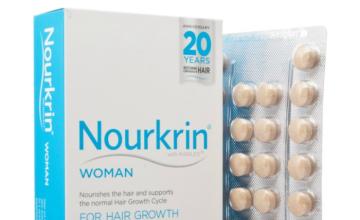
Balding men and women considering any hair loss treatment should take caution to believe the many magnificent claims made by today’s advertising. Far too often, a lot of time and money is wasted on questionable treatments with little or no proof of success.
Nourkrin hair nutrient claims to promote hair growth and strengthen thinning hair in 80% of men and women suffering from almost any hair loss condition other than the self-inflicted trichotillomania (hair pulling) or traction alopecia. Below we evaluate Nourkrin, the "clinical study", and its ingredients to find out whether or not this hair loss treatment lives up to its promises.
Nourkrin recommends using their complete regime of products for at least 6 months for the best results. This includes extra strength, Man, and Maintain oral tablets, a shampoo, a conditioner, and a scalp lotion. Nourkrin claims their products can promote hair growth in men and women suffering from androgenic alopecia (genetic baldness), alopecia areata, alopecia totalis, alopecia universalis, and telogen effluvium. This is a very bold claim considering each balding condition occurs for varying reasons.
The active ingredients in the extra strength tablet include shark cartilage and shellfish extract containing glucosamine. Other active ingredients include silica kieselguhr (a natural form of silica), horsetail extract, acerola cherry extract with vitamin C, microscyrstaline cellulose, immunogloblin G protein, and fatty acids. In addition to the above, the Man product contains Omega 3 fatty acids and Fenugreek designed to improve scalp circulation. Maintain includes additional marine life proteins, minerals, silica, and vitamin C. The scalp lotion contains marine life protein extract compounds and aloe vera.
Nourkrin claims that the primary active ingredient glucosamine can rebuild and grow new tissue, including dormant hair follicles - suggesting successful hair regrowth. Though clinical studies prove that glucosamine might be effective in reducing joint pain, increasing joint lubrication, preserving joint space, protecting cartilage breakdown by inhibiting specific enzymes, stimulating cartilage matrix repair, and other anti-inflammatory actions, we couldn't find any evidence to support claims that it can stop hair loss or promote hair regrowth.
Nourkrin conducted a clinical study of 60 people who took their products for 12 months. All subjects were over 18 years of age and suffered from at least some form of hair loss for at least one year prior to the study. During a 6 month double blind clinical study, 30 subjects took Nourkrin while the other 30 took a placebo. After 6 months, the 30 participants taking Nourkrin continued taking it for another 6 months while the 30 on the placebo were switched to Nourkrin for 12 months.
In the first 6 months, Nourkrin reports that 77% taking their hair loss treatment experienced an increase in hair growth and shaft thickness. After 12 months, 75% reported a decrease in overall thinning hair. 90% of women in the study reported overall hair improvement after 12 months. The hair counting method showed an average increase in hair count of 45 percent during the clinical study.
Though the above study sounds impressive, we don't know a lot about the participants nor can we be certain of the reliability of the study. All participants suffered from some form of thinning, but its cause for each patient hasn’t been disclosed. Additionally, clinical studies are considered more credible when they've been conducted or verified by third parties not interested in its financial success.
Another problem is that none of the active ingredients in Nourkrin are proven to stop hair loss. Therefore, their study is the only one balding men and women have to support such claims.
Anyone allergic to shellfish should avoid using Nourkrin. Women who are pregnant or breast feeding should not use Nourkrin hair loss products. Consulting with a doctor before using this treatment is advisable.
Nourkrin recommends taking 2 tablets daily for at least 6 months. Men and women over 176 lbs or those who smoke are advised to take 3 tablets daily. After 6 months, dosage can be cut down to one a day. Nourkrin also recommends using the shampoo, conditioner, and scalp lotion daily. The scalp lotion may be best applied in the evening and left on overnight.
60 tablets of the extra strength tablet costs about $75, the Man $65, the shampoo and scalp cleanser $12, the conditioner $13, and the scalp lotion $30. All in all, the Nourkrin Hair Recovery Program can get pricey after 6 months. FDA approved products like Rogaine (minoxidil)only runs approximately $15 a month or less and male treatment Propecia (finasteride)costs approximately $60 per month, not as expensive as Nourkrin.
Nourkrin boasts a big game, claiming high rates of success in reversing hair loss in men and women caused by varying conditions. Their clinical study also confirms its success rate however; the reliability of this study has not been verified by third parties uninterested in its financial success. Additionally, no clinical proof exists that any of the ingredients found in Nourkrin work to treat baldness.
Whether or not Nourkrin is the "real deal" is hard to determine with little evidence to support its claims. Therefore, those considering this treatment should proceed with caution and may want to consider exhausting proven treatments like Propecia and Rogaine first.

One product you used to see quite often in advertising is Avacor. According to Response magazine, Avacor was the third best selling product on the Internet in April, 2002. Avacor was originally manufactured by Global Vision Products. After being taken over by new management, it is now being manufactured by Avacor Products LLC.
Like most products that advertise 'Stop Hair Loss and Regrow Hair!', Avacor contains the only FDA approved topical drug minoxidil. Avacor, like other products with similar claims, mixes FDA approved drugs in their generic form with other ingredients in a multiple regimen of products like shampoo, lotion and vitamins.
Avacor historically cost approximately $239 for a two to three month supply and over $1000 for a year’s worth. New prices are much more reasonable which range from $180 for a 3 month supply to $400 for a year’s supply of the men’s and women’s formula. Note that the ingredients in Avacor can be bought over the counter at your local store at a fraction of the cost for which they are sold in Avacor. However, they do offer 24/7 customer service and a 90 day money back guarantee.
Avacor, like other products with similar claims, has taken a lot of slack over the years for their controversial marketing tactics. Avacor has a checkered past and has previously been the focus of lawsuits and investigative reporting by major media like ABC news. Recently however, new management has taken over and claims they are very serious about selling quality products at more reasonable prices, without the hype and controversial marketing strategies. In looking at their website, while Avacor still uses slick marketing language to promote their products, the vast majority of their claims are much more realistic.
Avacor includes 3 distinct products that claim to provide “total hair care”. This includes a 'Scalp Detoxifying Shampoo', a 'Physicians Topical Formulation' and finally a 'Nutricap'. Avacor's Nutricap ingredients consist mainly of common herbs like saw palmetto, gingko biloba, keratin, resveratrol, and bilberry. While conjectured to inhibit the production of DHT, none of these ingredients are FDA approved or proven to stop hair loss. Avacor’s Physician’s Topical Formulation however, does contain 5% of the FDA approved hair regrowth agent minoxidil.
Other than minoxidil, no other ingredient is proven to regrow hair. A number of studies have been done that suggest saw palmetto inhibits the production of DHT, like Propecia. But, unlike Propecia, it has never been proven to stop or reverse hair loss.
Avacor admits on their website that the only product proven to regrow hair is the Avacor Physician’s formulation which includes the FDA approved ingredient minoxidil (5% for men and 2% for women). The other products claim to provide hair with the essential nutrients for healthy hair growth but are careful not to claim to prevent the progression of male or female pattern baldness (androgenic alopecia). Perhaps this is why the Avacor Physician’s formulation can now be purchased separately. Costs of the Physician’s Formulation are still, but only a little more expensive than Rogaine topical hair loss treatment, one of the first and most popular topical minoxidil products.
At this time, Avacor’s proof comes in the form of the FDA approved study showing that minoxidil can stop and reverse hair loss. No other study is provided with their product. Their website also is much more realistic as to what their product line can accomplish for hair loss suffering consumers.
Before you consider spending hundreds of dollars for any product or service, do a review. Legitimate products will have legitimate studies and have been reviewed on many quality websites. Doctors with real talent and satisfied patients will be able to show you dozens of photos and allow you to talk with past patients. Proven physicians will make available their resumes along with their formal education and associations they belong to.
It is always best to review a product or doctor for information on their background before you make a decision for something as important as hair loss and hair restoration.
At the very least, the Avacor Physician’s formulation will be as effective as the Rogaine liquid formula or generic minoxidil. However, to date, both Rogaine and generic minoxidil are more cost effective than Avacor. The nutricap, shampoo, conditioner and other products may promote healthy hair and provide it with volume, but make no claims of stopping hair loss or regrowing hair.


Tricomin is an all natural hair loss treatment designed for both men and women with thinning hair to stimulate hair regrowth and improve the appearance of thinning hair. It can also be used in conjunction with with Rogainehair regrowth treatment.
Tricomin Solution Follicle Therapy Spray combines the benefits of the Triamino Copper Nutritional Complex with an exceptional leave-in conditioner. The therapy spray enriches your hair and scalp with a unique blend of mineral and body-building ingredients and essential amino acids. Spraying the therapy spray liberally after shampooing daily will condition and treat your hair and scalp. It's recommended to apply this product to damp or dry hair.
The Tricomin Revitalizing Shampoo stimulates and restores health, structure, and vitality to thinning, fine, and damaged hair. It's recommended to use the Revitalizing Shampoo daily, gently massaging it into moistened hair scalp, leaving on for 3 to 5 minutes before rinsing. A second application may be made if desired.
The Restructuring Conditioner uses a unique moisture and nutrient-rich framework to help restore your hair's natural mineral and protein balance. This conditioner helps to add structure and body onto thinning and/or damaged hair.
For best results, use all three Tricomin products in conjunction with one another. All 3 Tricomin products is called the Tricomin TricoPak.
Al three Tricomin products contain the active ingredient copper peptides. Scientific evidence suggests that copper peptides can shorten the shedding (telogen) phase and elongate the growth (anagen) phase of the follicles. Partial FDA trials showed Tricomin products' effectiveness in promoting new hair growth.
Tricomin copper peptide technology may provide marginal benefit to men and women with thinning hair. To date, only surgical hair restoration is proven to grow hair in completely bald areas. You are invited to have a free virtual consultation with one of our prescreened hair restoration physicians.
Tricomin Follicle Therapy Spray: Purified Water, SD Alcohol 40B, Amodimethicone, Nonoxynol-10, Panthenol, Polyquaternium-11, Polysorbate 60, Tallowtrimonium Chloride, Citric Acid, Dimethyl Lauramine Isostearate, Linoleamidopropyl Ethyl Dimonium Ethosulfate, Triamino Copper Nutritional Complex (Alanine/Histidine/Lysine Polypetide Copper HCl), Methylparaben, Benzethonium Chloride, Menthol, FD&C Blue #1.
Tricomin Revitalizing Shampoo: Purified Water, Sodium Laureth Sulfate, Disodium Cocoamphodiacetate, Cocomidopropyl Betaine, Ceteth-16, Glycerin, Laneth-16, Oleth-16, Steareth-16, PEG-75 Lanolin, Sodium Chloride, Triamino Copper Nutritional Complex (Alanine/Histidine/Lysine Polypetide Copper HCl), Citric Acid, Diazolidinyl Urea, Hydrolyzed Keratin, Panthenol, Methylparaben, Fragrance, Propylparaben, Peppermint Oil, D&C Red #33, FD&C Blue #1.
Tricomin Restructuring Conditioner: Purified Water, Glyceryl Stearate, PEG-100 Stearate, Stearamidopropyl Dimethylamine, Cetyl Alcohol, Propylene Glycol, Stearyl Alcohol, Dimethylamine, Triamino Copper Nutritional Complex (Alanine/Histidine/Lysine Polypetide Copper HCl), Hydroxyethylcellulose, Panthenol, Aloe Vera Gel, Soydimonium Hydroxypropyl Hydroxylyzed Wheat Protein, Hydroxylyzed Keratin, Citric Acid, Methylparaben, Fragrance, Disodium EDTA, Propylparaben, Peppermint Oil, Tocopheryl Acetate, Cholecalciferol, Retinyl Palmitate, Vegetable Oil, FD&C Blue #1, D&C Red #33.
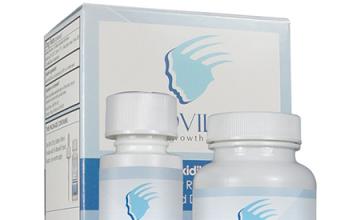
One of the more popular hair loss products on the market today for those with thinning hair is Provillus. Available for both men and women, making promises to “re-grow beautiful healthy hair”, this product consists of a topical and oral solution with an FDA approved hair regrowth ingredient and a number of conjectured “all-natural” dihydrotestosterone (DHT) blockers.
Other ingredients that promote a healthy scalp and head of hair are also contained in this product. The theory behind Provillus is to revive the hair follicles with growth stimulators and attack hair loss at its source by blocking DHT.
In order to fully evaluate the efficacy of this product, we must further explore each ingredient to determine whether or not this hair loss treatment delivers what it promises. Below you will find a list of ingredients and information that will help you determine whether or not Provillus is right for you.
Minoxidil (found in Rogaine, Xandrox and other solutions) is an FDA approved hair growth treatment and many balding men and women use it with great success. This particular ingredient is what allows Provillus to advertise their product as FDA approved.
Azelaic acid has been found to clean the skin and potentially inhibit DHT, the hormone responsible for androgenic alopecia.
Combining these two “forces” therefore in theory, may be a more powerful treatment than minoxidil alone. However, no clinical studies have been performed on azelaic acid as a standalone product therefore, whether or not it can stop hair loss is purely conjecture.
The Provillus oral solution contains a number of supposed DHT blockers including saw palmetto for hair loss, Vitamin B6 and Zinc, pumpkin or cucurbita maxima, and nettle root. Because evidence exists that these ingredients may be an effective treatment for benign prostatic hypertrophy (BPH), theories have been produced that they might also effectively treat baldness. Though we can appreciate the aspiration for balding men and women to use herbal products as an “all-natural” replacement for Propecia (finasteride), the problem we have is that most of them only contain anecdotal if any evidence at all that they can successfully treat baldness.
Provillus oral solution also contains a number of components that are said to promote healthy hair growth and cleanse the scalp. These include eleuthero, uva-ursi, muria puama, horsetail, para-aminobenzoid acid (PABA), and magnesium. Understand however, that promoting a healthy scalp and hair is not the same as stimulating newhair growth and hair regrowth, nor does it signify an effective hair loss treatment.
The only side effect that we could find listed on the Provillus website is an upset stomach. It is reported that taking it with food often stops this. Be sure to follow the links to the ingredients listed above as many of them also have potentially reported side effects. Consulting with a physician before taking any herbal hair loss medication is advised.
Currently there are no standards on dosages of herbal medications in the United States. In addition, no formal clinical studies have been performed on them for treating baldness. Therefore, the suggested daily value listed on the ingredient package is based on something other than government regulation and scientific study.
A one month supply of Provillus topical and oral supplement for men or for women costs about $50 per month. Discounted prices are available when bought in bulk.
For the cost of Provillus, one can purchase generic finasteride and generic minoxidil which are FDA approved hair loss treatments for safety and efficacy.
Given that Provillus topical treatment contains FDA approved hair regrowth ingredient minoxidil; we can at least agree that it may have some marginal benefit for men and women suffering from androgenic alopecia. However, due to the lack of compelling evidence in these other conjectured hair loss solutions, it may be more beneficial and cost effective to spend your money on Propecia (finasteride)for men only and Rogaine (minoxidil) that has helped balding men and women worldwide.
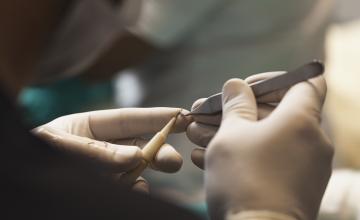
We believe that patients have a right to full disclosure and a complete understanding of exactly what hair restoration surgery involves.
This step by step presentation shows how today’s state of the art follicular unit hair transplant procedure is typically performed.
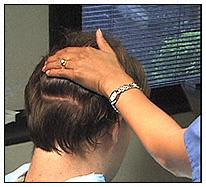
During surgery hair follicles from the back of the head that are genetically resistant to going bald will be removed and relocated (transplanted) to the balding areas.
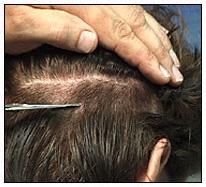
Prior to surgery, the hair in donor area that will be surgically removed is trimmed.
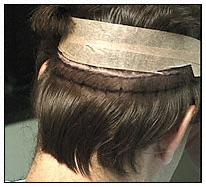
Once the donor area has been prepared it is given local anesthesia.
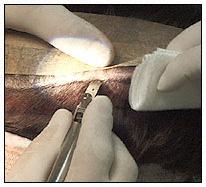
The donor tissue containing the bald resistant hair follicles is then surgically removed.
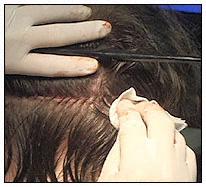
The donor tissue containing the bald resistant hair follicles is then surgically removed.
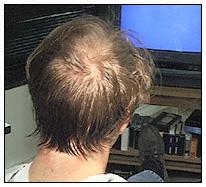
When patient’s hair is combed over the donor area the sutures are not visible. These sutures are typically removed approximately ten days after surgery.

Surgical technicians then use microscopes to view the donor tissue in order to dissect and prepare follicular units hair grafts.
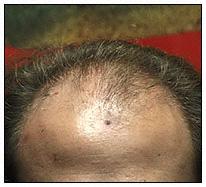
After being given local anesthesia, the balding recipient area is ready for surgery. No trimming or shaving of hair is needed in the top recipient area.
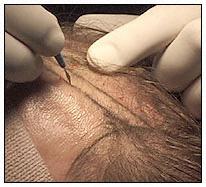
Tiny incisions are made in the recipient areas in irregular patterns that mimic nature. The follicular unit grafts will then be placed carefully into these tiny incisions.
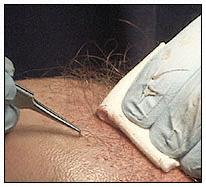
Follicular unit grafts are gently placed into the recipient incisions.
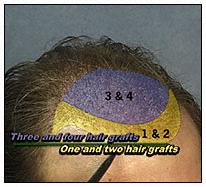
Typically the smallest one and two hair grafts are placed in the very front of the hairline, with three and four hair grafts placed behind them.
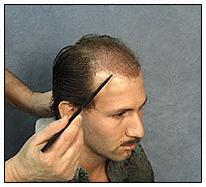
Following surgery a patient will have hundreds of tiny incisions with short hair stubble showing from the new grafts.
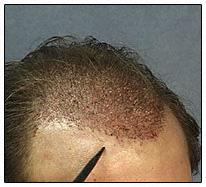
The tiny graft incisions heal rapidly. The redness and scabbing in the recipient area normally clears up within about one week.
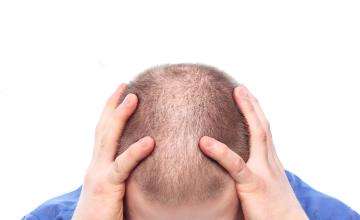
Maybe you’ve heard that wearing a tight baseball cap too often will make you bald or that if you wash your hair too much you’ll suffer hair loss. Well, they’re both old wives’ tales.
So what really causes hair loss and what’s myth?
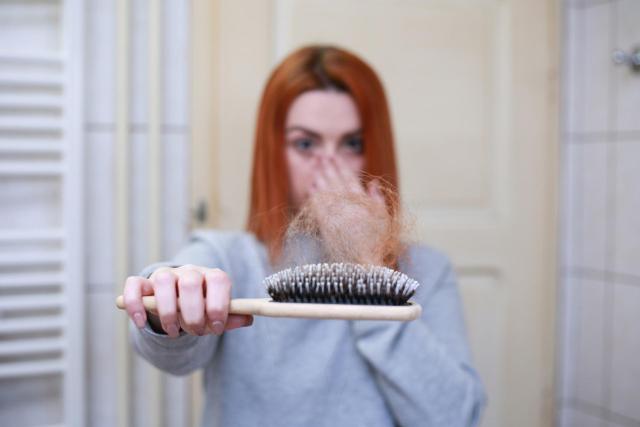
The idea of brushing the hair 100 times a day to stimulate the scalp circulation is a fantasy. In fact, if you brush your hair too much, you may end up injuring and losing hair.
This myth stems from the thought that hair loss was due to poor circulation and that brushing or massaging would improve blood flow and nutrition to the follicles. The truth is, bald or not, there’s no major difference in scalp circulation.
There’s some truth and some fiction when it comes to hair styling and Hair Loss.
It is true that certain hair styles, such as corn-rows or tight ponytails, can cause hair loss. These styles put undue tension on the hairs. But as for hair sprays, perm solutions, or coloring resulting in hair loss there’s no truth to that idea. These applications may cause some damage to the hair strands. But the all-important follicles, located under the skin, stay safe.
And what about the idea that haircuts will make your hair grow back thicker and faster? That’s wishful thinking. Everyone’s hair growth and length depends on their own unique hair cycle, which is based on both nutrition and heredity. The longer your growth phase the longer your hair growth.
What about hair dryers? Are these follicular incinerators?
The good news is there is no evidence that hair dryers cause thinning hair. However, too hot or too much drying may lead to brittle and breakable hair. Let common sense guide you and hold the hair dryer at a normal distance from your scalp and dry to your heart’s content.
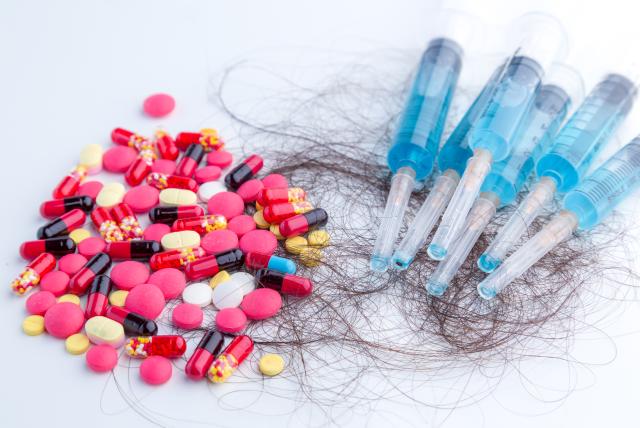
Think about this – if you were losing hair because of a lack of vitamins or minerals in your diet, why wouldn’t the back and sides of your head be affected? In actuality, vitamin deficiency results in an even distribution of hair loss all over the head. Of course, it doesn’t hurt to take vitamins on a regular basis for your overall health.
Your follicles width and amount are based on heredity. So claims of hair growing miracle drugs or natural hair loss treatments are untrue.
However, steroids use can cause hair loss. Research has proven that anabolic steroids raise the levels of baldness-inducing male hormones. For those who are genetically prone to hair loss, this can speed up the loss in as little as 3 to 6 months. While this loss may be reversed, it can be permanent.
Unfortunately, there is no truth to the idea that the more sex you have, the less hair you’ll lose! And the same goes for the rumors that the chemicals released during sex can affect hair loss. Science has yet to uncover any proof to this fantasy. But that doesn’t mean you shouldn’t keep experimenting.
Many men believe that if their father has a full head of hair, they’ll keep a good head of hair. But hair loss or hair growth is set by a genetic combination determined by both sides of your family.Of course, if your family tree is filled with balding scalps, you do have a better chance of losing hair.
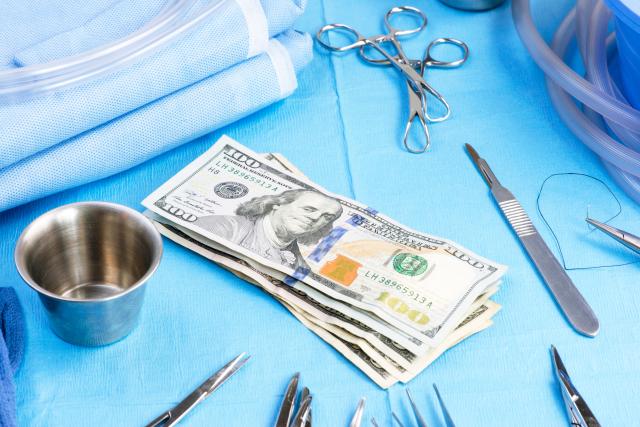
While hair loss sufferers spend small fortunes on treatments based on myths, there are several proven treatments, non-surgical and surgical.
Currently there are only two non-surgical hair loss treatments that are FDA approved for Hair loss. These two are Propecia (Finasteride) and Rogaine (minoxidil).
Other treatments may or may not help stop or reverse hair loss, but they are not formally approved by the FDA
To learn about proven treatments visit our Hair Loss Solutions section.
 Para-Aminobenzoic Acid (PABA) has been called the anti-gray hair vitamin and is considered one of the lesser known members of the vitamin B complex family (despite the fact that it’s not really a vitamin at all). PABA is a non-protein amino acid and isn’t essential in the human body. It can be found in foods such as liver, whole grain, yeast, and kidney and is listed as an active ingredient in several popular herbal hair loss treatments such as Provillusfor women and Procerin.
Para-Aminobenzoic Acid (PABA) has been called the anti-gray hair vitamin and is considered one of the lesser known members of the vitamin B complex family (despite the fact that it’s not really a vitamin at all). PABA is a non-protein amino acid and isn’t essential in the human body. It can be found in foods such as liver, whole grain, yeast, and kidney and is listed as an active ingredient in several popular herbal hair loss treatments such as Provillusfor women and Procerin.
The potassium salt in PABA called POTABA is available on prescription. POTABA is indicated for Peyronie’s Disease and scleroderma. The dose for Peyronie’s disease and scleroderma is very high (12 grams daily in 4 to 5 distributions) and must only be used under medical supervision. Because of the high doses needed to achieve clinical efficacy, patient compliance is typically poor.
But can PABA actually treat male pattern baldnessor genetic female hair loss?
Some tests conclude that PABA when combined with other elements such as folate, biotin, and pantothenic acid, may restore pre-maturely graying hair to its natural color. Some anecdotal reports suggest it might also stop hair loss, however; there are at least as many reports that contradict this. Moreover, we haven’t seen any evidence to suggest it can stimulate new hair growth or hair regrowth.
PABA comes in doses of 100mg, 250mg, and 500mg as a standalone product. However, since no formal clinical studies have been performed on PABA for hair loss, a suitable dosage is mostly speculation. Additionally, since no regulations have been placed on herbal medication, one should proceed with extreme caution before taking any herbal supplement. Consulting with a doctor is advised.
Some manufacturers of herbal replacements to medication would have you believe that herbal treatments come without potential side effects. However, this is a farce.
The following side effects have been reported from consumers of PABA: Anorexia, vomiting, nausea, hypersensitivity, fever and rash (particularly with larger doses). These symptoms went away when PABA is stopped.
Ironically, Provillusonly includes PABA in the woman’s formula. However, women should know that pregnant women, nursing mothers, and children should avoid using PABA.
For those with renal disease, PABA should be used with caution. PABA should be stopped if hypersensitivity develops. Those taking pharmaceutical doses of PABA must be under medical supervision.
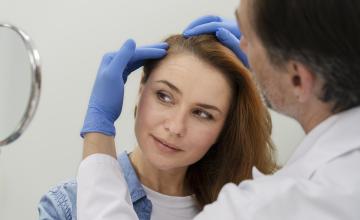
These types of treatments work by stimulating hair growth. However, they can't stop hair loss completely as they don't address the root causes of hair loss. Products that act to stimulate hair growth include Rogaine, Tricomin, Folligen, Proxiphen (along with Prox-N and Nano Shampoo) and Retin-A.

Tricomin, which is used by men and women, is a topical spray that has undergone a wide variety of scientific testing. The spray’s main ingredient is copper, which has been proven to be beneficial for hair.
The FDA has conducted some clinical studies, with the subjects applying the treatment twice per day for 24 weeks. These results were shown to be very positive. However, the product’s parent company, ProCyte Corporation, chose to release Tricomin as a cosmetic. They wanted to avoid the FDA approval process, which tends to be very lengthy.
Tricomin may be an effective option for those who want a treatment that’s undergone scientific testing, yet isn’t drug-based.
The product can be used safely by men, women and children. It’s also non-irritating and has no known side effects. Tricomin can be used for any type of hair loss
The product should be sprayed to damp or dry hair twice each day. But if you’re using another topical treatment, such as Rogaine, you should wait a few hours before applying Tricomin. This is because the scalp may turn a greenish color when mixed with other products. However, this discoloration isn’t permanent and washes out. And like other treatments, Tricomin needs to be used regularly to maintain its results.
Besides the spray, Tricomin is available as a shampoo and conditioner. They should be used as an addition and not as a replacement, though.
For more detailed information of Tricomin Follicle Therapy Spray, Shampoo and Conditioner, click here.

The makers of Tricomin make this product, available as a cream, lotion and spray. It was originally designed as a skin repair cream in the Dermatology Department at the University of California at San Francisco.
However, a 41-year-old woman with severe hair loss re-grew lost hair in two and one-half months with the cream. The company, Skin Biology, has since marketed this cream, which also contains copper-peptide as a hair loss treatment. The blue-colored copper-peptide complexes are meant to improve hair vitality and the health of the scalp and hair follicles.
Folligen products are meant for both men and women. They feature a cream for hairline application, spray for overall use, and lotion for bald spots. While Folligen may work on its own, its best results may be seen when it’s used with products like Rogaine.
Essentially, Folligen’s products soothe irritated scalps. They also relieve the itching and burning associated with Rogaine. However, the Folligen spray may cause itching or burning. Also, because the cream and lotion are bright green, it’s better to use them at night, while covering your pillow.
And while you can wash Folligen off easily, it’s not advisable for people with very light blonde hair to use the product. They may develop a greenish tinge to their hair.
Proxiphen is a prescription formula topical cream that has not yet received FDA approval. It combines the power of minoxidil and other chemicals. The cream should be applied everyday for the first 8 - 12 months, and after that, every other day. Proxiphen is dispensed only when a physician gives a diagnosis of hair loss.
Proxiphen-N, the non-prescription Proxiphen is less expensive and is also not as strong. It’s advisable for patients to use minoxidil with Proxiphen-N.
NANO (nicotinic acid N-Oxide) shampoos and conditioners are an excellent compliment to your existing minoxidil treatment. They contain NANO, which is a minoxidil-like hair growth stimulator. They also have agents that stimulate hair growth. These products are beneficial when used with Proxiphen and Proxiphen-N.
In order to see some results, Proxiphen-N and the NANO products need to be diligently used for at least 8-10 months at the very least.
A one-month supply at prescription strength is about $100. A 2-month supply of Proxiphen - N will cost $59.95. A 90-day supply of NANO Shampoo and Conditioner will cost $39.95 and $29.95, respectively.
Retin-A (also known by its scientific name, tretinoin gel 0.1%), is a topical treatment that’s primarily used as an acne medication. However, research has shown that Retin-A, either by itself or with Rogaine, may grow some hair in those with male pattern baldness or female pattern baldness.
To use Retin-A, you should apply a thin layer with a gauze pad or cotton swab to the affected areas at bedtime. Remember to wash your hands immediately after using the product! You should also take care not to get any Retin-A near the eyes, mouth, or open cuts. The medication may irritate sensitive skin.
It should also be mentioned that if Retin-A is used more often, the results will not improve. Rather, the side effects may increase. These effects include an immediate warming of the skin. Other skin problems may include peeling, itching, scaling, redness and maybe mild stinging. Luckily, once your skin adjusts to the medication, these effects should subside.
Retin-A may also cause increased sensitivity to sunlight as well as wind and cold. For these reasons, you should avoid prolonged exposure to the sun and sunlamps. You should also use effective sunscreens, and wear protective clothing.
In regards to pregnant mothers, research hasn’t shown any risk of birth defects, as of yet. Nevertheless, physicians recommend using Retin-A during pregnancy only if necessary. You should also consult your doctor before breast-feeding. One tube of Retin-A Cream can be purchased for about $28.00.
Click to learn more about Superoxide Dismutase (SOD's)
